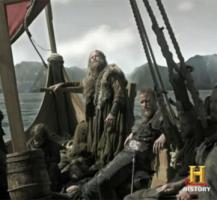
Wrong-side rudder
Vikings is a History Channel series that follows the exploits of the legendary Viking leader Ragnar Lodbrok. It is basically lots of fun, with swords and axes flying, supported by a fair share of intrigue and drama, the sort of show that will tide Game of Thrones fans over until that series finally starts again.
How historically accurate the series is open to question. The tattoos and shield maidens have some, if not a lot, of support in the sagas. And tattoos and kick-ass women are popular these days, so why not? One detail, however, is bizarrely inaccurate. All the Viking longships in the TV series have their rudders on the port side, the wrong side. (Oddly, the Frankish ships in the series have the rudder on starboard sight, literally the right side.)
So why does this matter? Am I being a petty nautical history wonk? Basically, who cares? OK, I will admit that in the grand scheme of things, it doesn’t matter. It hasn’t ruined the series for me. Nevertheless, it is of some it importance and here is why.
The position of the Viking rudder effects us to this very day. The reason that the USS Fitzgerald may bear a significant percentage of the fault in her recent collision with the container ship ACX Crystal is all related to Viking rudders. The COLREGS and Rules of the Road still reflect the placement of the ancient steering oar.
Early rudders evolved from steering oars off the ship’s stern quarter. (Center-line rudders with pintles and gudgeons were not fully adopted in Europe until around the 14th century.) The rudders on Viking long ships and other ships of the period were always on the right-hand side.The word starboard come from the Old English word stēorbord meaning ‘steering side’ or ‘rudder side.’
To prevent damage to the steering oar, ships were commonly docked on the port or larboard side. Larboard is from the Middle-English ladebord or ‘loading side.’ The left side of a ship was referred to as the larboard side until 1844 when the Royal Navy ordered that port be used because larboard and starboard sounded too similar when shouted in battle or during critical maneuvers.
So, what does this have to do with the Rules of the Road? The starboard side was favored so as not to damage the steering oar. That preference remains today in the rules governing crossing situations, where the vessel approaching from starboard generally has right of way. The so-called danger zone is from dead ahead to two points (about 23 degrees) abaft the starboard beam. Any vessel approaching in that zone generally has the right of way.
When the container ship approached the USS Fitzgerald from the starboard side, all else being equal, the Navy ship had the responsible to maneuver to avoid a collision. (This did not absolve the container ship from responsibility for maintaining a lookout or of doing everything possible to avoid an imminent collision.)
Why is the right of way on the starboard approach and not the port? It is the tradition that dates back to the steering oars of Viking ships, which is why the TV Vikings should have gotten it right, but didn’t.

Fascinating history lesson. Thanks Rick.
I don’t care what the Rules of the Road are when it comes to a capital ship of the U.S. Navy. It had the maneuverability and obligation to avoid the collision and was well aware or at least should have been that it was in a channel for commercial ships with varying levels of training and expertise. A DDG of the Arleigh Blake class should not come within, nor allow any other vessel to come within a mile of it.
“The Common Sense Law of Gross Tonnage”: If it’s significantly bigger than you are, stay out of the way.
I loved the way you presented this information and tied-it to the accident involving USS Fitzgerald. I wonder if watch-standers in the Navy or Merchant service ever had the same lesson explaining the origins of starboard and larboard/port.
Kudos, Rick!
great post!
One of my pet peeves or trivial information for non sailors. Every chance I get I let people know about starboard right of way.
😛
The etymology of Port, Starboard, and Larboard were part of my NROTC studies in at university in 1957, as was the rules of the road.